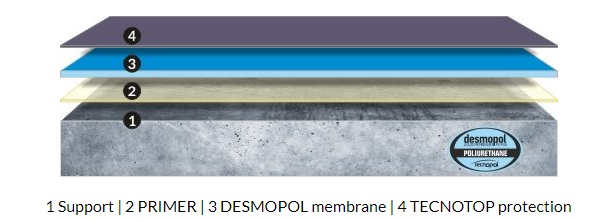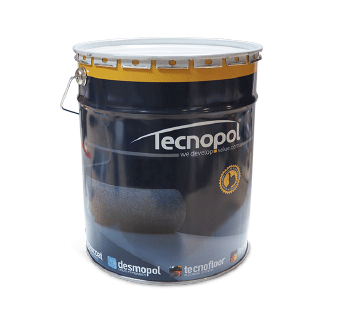Desmopol System

Desmopol liquid membrane system. Liquid membrane systems make it possible to implement designs and architectural conceptions out of the ordinary. The systems are applied in both new constructions and renovations, when the use of synthetic membranes proves to be a complicated process and cannot guarantee fast, efficient and safe application. Wet membranes offer the advantage of easy adaptation to intricate details and are the ideal choice for renovations of existing rooms. One of the biggest advantages of liquid membrane systems is the fact that several times, the existing sealing layer does not need to be removed (except in some cases - consult our technical department). Wet membranes and Desmopol are applied in combination with suitable primers if required, directly on the roof surface.
 Application Procedure:
Application Procedure:
- First inspect the concrete including the railings. The surface should be uniform without imperfections and free of cementitious skin, gaps or nests. For gaps and imperfections that need repair or smoothing you can use the polymer repair mortar SikaRep 300 Classic or Kimia BetonFix FB for application thickness 0.5-3 cm per layer and Kimia BetonFix RS for application thickness up to 5 mm per layer. Then follows the good cleaning of the surface freeing it from dust, etc.
- Then, thoroughly open the cracks in the substrate, remove the dust and prime them with Sika Primer 3N using a brush. About 15 minutes after priming, seal the cracks with Sikaflex 11FC+ polyurethane sealant. Optionally in the corners you can use the self-adhesive sealing tape Domoproof Elastoband.
- Then prime the entire surface with Primer PU-1000 polyurethane primer. It is easily applied with a roller & brush.
- Before the next layer, make sure that the primer layer has completely dry and does not "stick". Then apply the first coat of Desmopol polyurethane in white or grey. While the first coat is still fresh, the fiberglass Waterproofing Mat must be boxed in it to achieve a fully reinforced system.
- Repeat the layer of polyurethane (2nd coat) until the glass is completely covered. If necessary, apply another coat (3rd coat). Caution: the coating of the system must always "turn" vertically on the parapet and if possible cover it completely.
- Finally, apply the final Tecnotop 1C sunscreen. For cases of high demands (extreme temperatures, partial walkability, etc.) apply the protective coating Tecnotop 2C in white or gray color. In case there is a need to achieve a non-slip surface, incorporate in Tecnotop 2C the special microscopic Tecnoplastic C or Tecnoplastic F polyamide beads in a dosage of 1-5%.
Remarks:
- All materials are applied based on specifications.
- The materials start to react with the air as soon as the container is opened. Design the application so that you can ideally use all the material in one use. The container cannot be sealed and reused.
- Bituminous materials containing volatile compounds may stain and / or soften under the coating. Low melting point asphalt materials may need to be primed - the use of a dark tint also helps to hide any stains from volatile compounds. Always use a fully reinforced system.
System materials:
- Waterproofing Mat
- Domoproof Elastoband
- Tecnoplastic C/Tecnoplastic F
- Tecnotop 1C/Tecnotop 2C
- Primer PU-1000
- Desmopol
*Download the 25 year lifetime ETA certification here.
Video
RELATED ARTICLES

Άριστη και εύκολη λύση για τη θερμομόνωση των δωμάτων

Cement Tile Adhesives and what we need to know

Polyurethane and polyurea sealing membranes

Underfloor Heating Coating

SikaCor®-146 DW System


